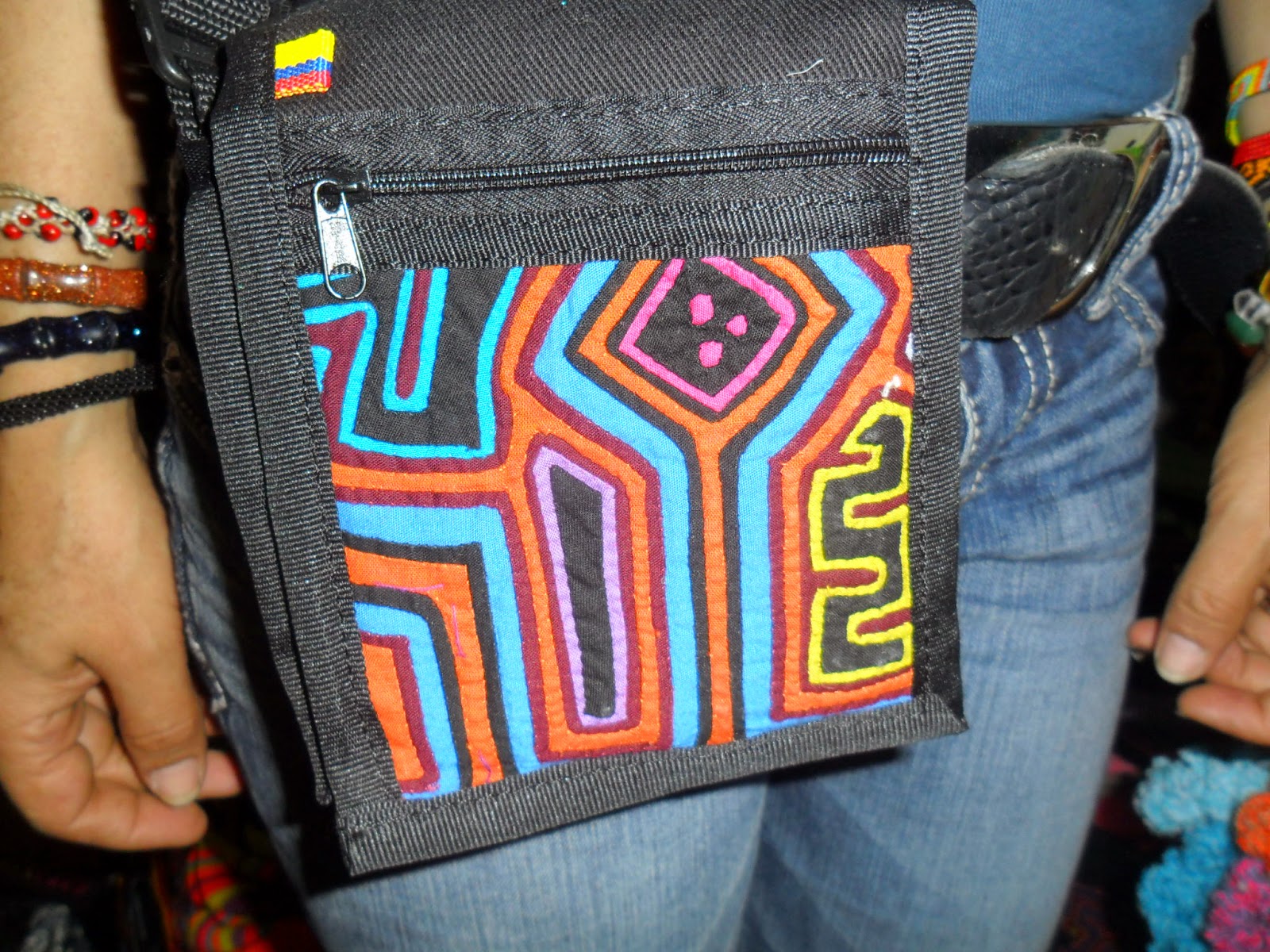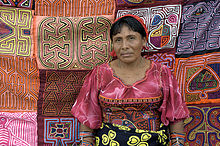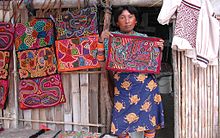MOLA ARTICLES BY KUNAS :BAG-WALLETS -BLOUSE-BELT-COSMETIC-CAPS-
Los Kuna, Cuna o Guna.
son un pueblo amerindio localizado en Panamá y Colombia. Su idioma hace parte de la familia lingüísticachibcha. En lengua kuna, se autodenominan como dule (Se pronuncia Tule) que significa "persona". (Por ejemplo, andule 'yo,' we dule 'esa persona.')
(Según las convenciones lingüísticas de este pueblo indígena su nombre se debe escribir Gunadule en la grafía aprobada en 2010 por el Congreso General de la Nación Gunadule, aunque su pronunciación se mantiene como ha sido tradicionalmente: suena Kuna Tule según la fonética de la lengua española.1 )
Su civilización ha salido en los medios masivos en 2014 al ser uno de los primeros pueblos que podrían ver afectada da manera drástica su vida milenaria por el cambio climático.
From Wikipedia, the free encyclopedia
The mola forms part of the traditional outfit of a Kuna woman, two mola panels being incorporated as front and back panels in a blouse. The full costume traditionally includes a patterned wrapped skirt (saburet), a red and yellow headscarf (musue), arm and leg beads (wini), a gold nose ring (olasu) and earrings in addition to the mola blouse (dulemor).[1]
In Dulegaya, the Kuna's native language, "mola" means "shirt" or "clothing". The mola originated with the tradition of Kuna women painting their bodies with geometrical designs, using available natural colours; in later years these same designs were woven in cotton, and later still, sewn using cloth bought from the European settlers of Panamá.
Development of the style
Molas have their origin in body painting. Only after colonization by the Spanish and contact with missionaries did the Kuna start to transfer their traditional geometric designs on fabric, first by painting directly on the fabric and later by using the technique of reverse application. It is not known for certain when this technique was first used. It is assumed that the oldest molas are between 150 and 170 years old.
As an inspiration for their designs, the Kuna first used the geometrical patterns which have been used for body painting before. In the past 50 years, they also started to depict realistic and abstract designs of flowers, sea animals and birds.
Depending on the tradition of each island, Kuna women begin with the crafting of molas either after they reach puberty, some even at a much younger age. Women who prefer to dress in western style are in the minority as well as in the communities in Panama City.
Molas have such an importance for the Kuna and their traditional identity that they can be made responsible for the independent status of the Comarca San Blas. After the attempt of the Panamanian government to "westernize" the Kuna in the beginning of the 20th century by forbidding their customs, their language and their traditional dress, a huge wave of resistance arose. This resistance movement culminated in the Kuna revolution of 1925 where, after heavy battles, the Panamanian government had to make the concession of giving the Guna people the right to govern their own territory autonomously.
Construction[edit]
Molas are handmade using a reverse appliqué technique. Several layers (usually two to seven) of different-coloured cloth (usually cotton) are sewn together; the design is then formed by cutting away parts of each layer. The edges of the layers are then turned under and sewn down. Often, the stitches are nearly invisible. This is achieved by using a thread the same color as the layer being sewn, sewing blind stitches, and sewing tiny stitches. The finest molas have extremely fine stitching, made using tiny needles.
The largest pattern is typically cut from the top layer, and progressively smaller patterns from each subsequent layer, thus revealing the colours beneath in successive layers. This basic scheme can be varied by cutting through multiple layers at once, hence varying the sequence of colours; some molas also incorporate patches of contrasting colours, included in the design at certain points to introduce additional variations of colour.[3]
Molas vary greatly in quality, and the pricing to buyers varies accordingly. A greater number of layers is generally a sign of higher quality; two-layer molas are common, but examples with four or more layers will demand a better price. The quality of stitching is also a factor, with the stitching on the best molas being close to invisible. Although some molas rely on embroidery to some degree to enhance the design, those which are made using only the pure reverse-appliqué technique (or nearly so) are considered better.
Molas will often be found for sale with signs of use, such as stitch marks around the edges; such imperfections indicate that the mola was made for use, and not simply for sale to tourists.[1] A mola can take from two weeks to six months to make, depending on the complexity of the design.
Molas in Kuna Culture
The traditional costume of a Kuna woman consists of a patterned blue cotton wrapped skirt, red and yellow headscarf, arm and leg beads, gold nose rings and earrings and the many layered and finely sewn mola panel blouse.
The artistry of a mola reflects a synthesis of traditional Kuna culture with the influences of the modern world. Mola art developed when Kuna women had access to store bought yard goods. Mola designs are often inspired by modern graphics such as political posters, labels, pictures from books and TV cartoons, as well as traditional themes from Kuna legends and culture.
Geometric molas are the most traditional, having developed from ancient body painting designs. Many hours of careful sewing are required to create a fine mola. The ability to make an outstanding mola is a source of status among Kuna women.
The quality of a mola is determined by such factors as
- the number of layers
- fineness of the stitching
- evenness and width of cutouts
- addition of details such as zigzag borders, lattice-work or embroidery
- general artistic merit of the design and color combination.
When Kuna women tire of a particular blouse, they disassemble it and sell the molas to collectors.
Since mola panels have been worn as part of the traditional dress of a Kuna woman they often show signs of wear such as fading and stitch marks along the edges of the panels. These "imperfections" indicate that the mola is authentic and not made solely to be sold to tourists.
Molas are often sold in pairs, the pair consisting of the back and front panels of a blouse. The two molas are usually two variations on a theme. Matched molas complement each other and should be displayed or used together for the greatest impact.
Mola panels have many uses. They can be framed as art or made into pillows, place mats or wall hangings. Some people even make them into bedspreads or incorporate them into quilting projects.
Molas are very sturdy and well sewn. Authentic molas have already been washed many times and can be safely hand washed in warm water.
Molas may be purchased in Panama or in Colombia.
The mola blouse is an important symbol of Kuna culture.
Sizes S,M.L,XL
Weight 80 gr.

REF 6842
REF 6843
REF 6841
REF 6940
INTERIOR BOLSO
6836
15 X 12 CENTIMETROS
REF 6737
REF 6936
REF 6835
18 X 14 CMTS
REF 6833
6834
REF 6842
REF 6826
35 X 28 X8 CTMS
REF 6825
REF 6824
REF 6823
REF 6822
ref 6820
BILLETERAS-MUCHOS DISENOS EN STOCK
REF 6818
REF 6817
REF 6916
REF 6815
REF 6814
REF 6813
REF 6812
REF 6811
REF 6810
LEATHER BAG
WITH MOLA
WITH MOLA
CARRIEL EN JEANS AND MOLA
GORRA EN MOLA Y DRIL
S,M,L,LX
REF 1075
GORRA EN CON VISCERA CUERO Y MOLA
8.5 X 5.8 CM
REF 107502
REF 1348
LEATHER AND MOLA
Many Designs in stock
MOLA BAGT REF 1362
14 X 37 CM
WEIGHT: 450 GR.
MANY DESIGNS IN STOCK
Please ask
BAG
LEATHER AND MOLA
REF 1000
Sizes S,M.L,XL
Weight 80 gr.
REF 1001
REF 1002
REF 1003
ARTICULOS ELABORADOS CON MOLAS
TELAS Y CUEROS.
SOLICITA CATALOGO-ASK FOR PRICE CATALOG
REF 100101
REF 1000
REF 1005
CINTURON MOLA DRIL DELGADO
TALLA S,M,L,XL
PESO 90 GR.
REF 1362
HOJALETE
14X37 CMTS
PESO 450 GR.
REF 1363
PLANO MOLA Y CUERO CORTO
35 X 32 CM
PESO 65GR
REF 1368
BOLSO PABLO MOLA
REF 1385
BOLSO MAFE 27X32CM
REF 1801
BOLSO UNIVERSITARIO CUERO MOLA
28 X 30 CM
REF 1807
BOLSO TALEGA NARIPOSA TRANSLUCIDO
25 X 22 CM
PESO 700 GR.
REF 1808
EJECUTIVO DAMA
TERMINADOS A MANO
32 X 40 CM
PESO 420 GR.
REF 1810
BOLSO AL CRTE TRANSLUCIDO
33.5 X 40 CM
REF 1812
BOLSO CUADRANTE
REF 1348
BOLSO FLOR DE LIS
REF 1360
MORRAL JULIA
30 X 34 CM
REF 1822
BOLSO IVAN
PRECIO $ 115.000
REF 1817
REF 1397
BOLSO MOLA Y CUERO ANDREA
640 GR.
REF 1816
BOLSO CHUMBE
REF 1000801
PORTA CELULAR ECONOMICO
7 X 12 CM
30 GR,
REF 1009
PORTA ESFERO Y CUERO CILINDRO
REF 10091
PORTA ESFERO CILINDRO DRIL
REF 1010
PORTA ESFERO MOLA Y CUERO ECONOMICO
18 X 5.7CM
PESO 33GR.
REF 10101
PORTA IPHONE TARJETERO
11.3 X 14.8CM
PESO 83GR.
REF 10101
REF 107502
GORRA CON VISERA CUERO Y MOLA
8.5 X 5.8 CM
A4 GR.
REF 10951
MONEDERO FINA
9.5 X 7 CM
42GR.
REF 10951
MONEDERO FINO
9.5 X 7 CM
42 GR.
REF 1071
DELANTAL MOLA
TALLS S,M.L,XL
70 GR.
REF 1098
CANGURO CUERO
PILLOW COVER
50 X50
PORTA LAPIZ
MONEDCERO DOS CIERRES
MONEDERO BOTOS
PORTA CELULAR BOLSILLO
BOLSO BILLETERA CUERO DOBLADO
BOLSO PRENSES
COSMETIQUERA TREBOL
BILLETERA 3 CUADROS
BILLETERA PORTACHEQUERA
BILLETERA CREMALLERA
MONEDERO
BOLSO BILLETERA
ESTE BOLSO SE PUEDE COLOCAR EN
LA CINTURA COMO CANGURO-O
CRUZADO COMO BOLSO NORMAL
BOLSO BILLETERA - ANTERIOR
BOLSO MINICOHETE
COLOCAR EN LA CINTURA-CANGURO-O
CRUZADO CMO BOLSO NORMAL
PORTA CELULAR DOS CIERRES
VIENE CON UNA CORREA LARGA YA
SEA PARA LLEVARLO TERCIADO O
A LA MANO
PORTA CELULAR DOS CIERRES
ANTERIOR
BOLSO PASAPORTE
BOLSO 6 CUADROS
BOLSO MOSQUETON
SE PUEDE COLACAR EN LA CINTURA-CANGURO-
O LLEVAR COMO BOLSO NORMAL
BOLSO AJEDREZ SENCILLO
BOLSO AJEDREZ DOBLE
ESTE BOLSO TRAE UN BOLSO MAS QUE
EL AJEDREZ SENCILLO
LLAVEROS CORAZON
BOLSO TAPA TEJIDA
BOLSO COLAHS
BOLSO PERA
PASAPORTE CUERO DOBLAD



























































































































No hay comentarios.:
Publicar un comentario